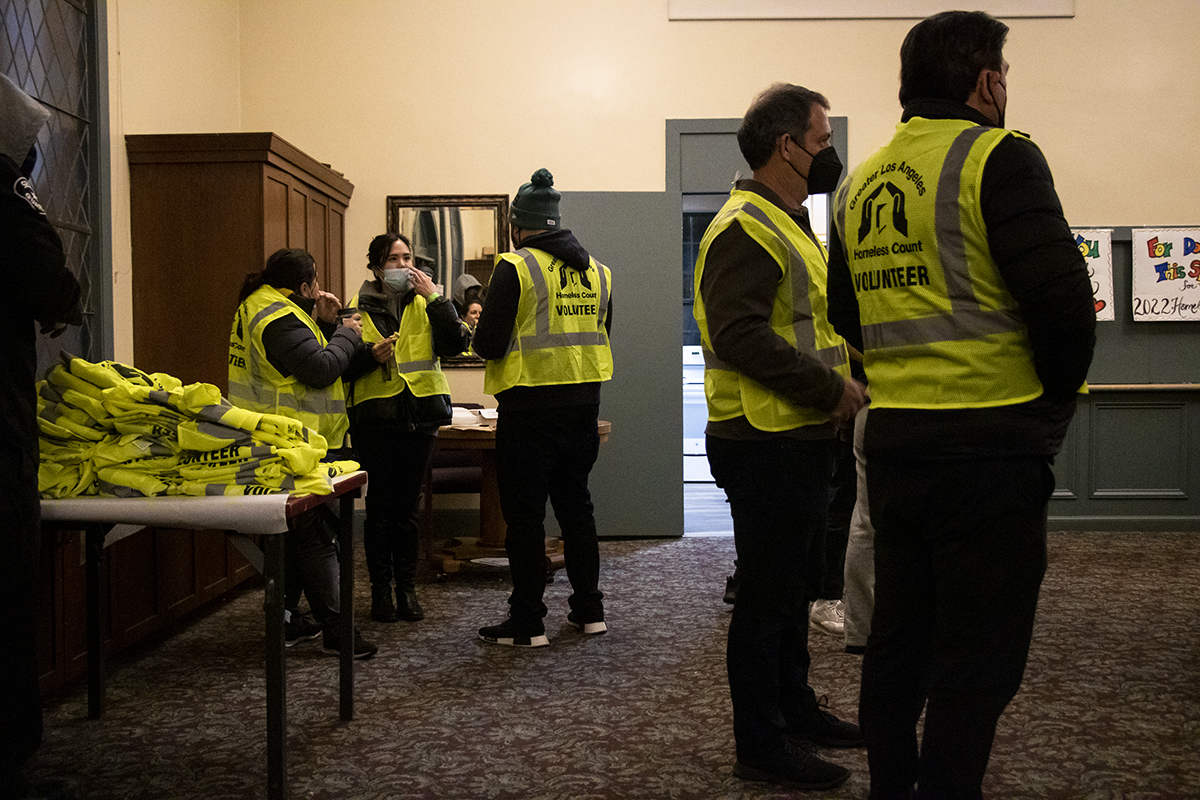Community members volunteer for Greater Los Angeles Homeless Count in Westwood

More than 100 volunteers attended the Greater Los Angeles Homeless Count in Westwood on Wednesday night, initially meeting at the Westwood Presbyterian Church. The volunteers walked through different areas to help determine how many people are experiencing homelessness in Westwood. (Finn Chitwood/Daily Bruin)
Volunteers in Westwood conducted the Greater Los Angeles Homeless Count this past week after delays due to the COVID-19 pandemic.
Approximately 100 volunteers fanned out across Westwood for two hours Wednesday to participate in the annual homeless count. The count took place from Tuesday to Thursday across Los Angeles County after being postponed because of the omicron variant-driven COVID-19 surge.
The Los Angeles Homeless Services Authority did not go forward with the homeless count in 2021 in order to prevent COVID-19 transmission between volunteers, staff and individuals experiencing homelessness.
The count in Westwood was co-sponsored and organized by the Westwood Neighborhood Council, which represents parts of Westwood in the Los Angeles City Council, and Westwood Community Council, a nonprofit corporation. Volunteers included Westwood homeowners, renters, students and other community members.
While the precise count cannot be determined until the LAHSA releases the records, Lisa Chapman, the president of WWNC and co-chair of the count, said she was surprised at some of the preliminary numbers from volunteers. They were higher than expected in certain areas even though she had already assumed the count to rise this year, she added.
This year was the first time volunteers utilized a mobile app called Akido Connect – developed by a digital health lab at the University of Southern California – instead of a pen and paper to keep a tally of their count. The move to digitize the count was meant to streamline operations and improve subsequent data analysis.
Although there were no reported technical difficulties with the app, Chapman said the new tallying method blocked site coordinators such as herself from viewing the count concurrently, even though LAHSA stated coordinators would be able to view data for their tract.
“Normally after our count, we have a general idea of what our numbers are and how they compared to the last year, so … it would have been nice to see it in real time,” Chapman said.
In 2020, LAHSA reported a 12.7% increase in the number of people experiencing homelessness in LA County from the year prior. In the same year, LAHSA reported 184 individuals experiencing homelessness in Westwood, which was a 29.6% increase from 2019.
LAHSA resumed its annual homeless count this past week, which provides a point-in-time snapshot of the homeless population at the beginning of every year. The census data guides state and federal funding allocations.
This year’s data will be the first to capture the long-term impacts of the COVID-19 pandemic, which marked its beginnings in January 2020.
The North Westwood Neighborhood Council, which serves as an advisory body to the City Council, plans to address homelessness by offering grants to Westwood organizations that provide services for people experiencing homelessness, said NWWNC President Furkan Yalcin. At its next meeting, NWWNC will also discuss the enforcement of LA’s controversial anti-camping law and file a community impact statement for the city council to review, he added.
[Related: Newly passed motion bans homeless encampments in select West LA locations]
Homelessness has long been a critical topic of discussion for LA political hopefuls. Four of the five mayoral candidates present during the first debate on Feb. 21 declared that homelessness is the biggest issue in LA. The topic of homelessness is also at the center of the election campaigns for LA City Council District 5.
District 5, where Westwood is located, has consistently ranked lower in homeless counts compared to the other districts, averaging approximately 1,030 individuals experiencing homelessness in the span of six years compared to 6,890 in District 14 during the same period.
Though LAHSA increased the frequency of the count from biennial to annual in 2016, Andrew Lewis, vice president of the North Westwood Neighborhood Council and a volunteer at the count, said he felt the count should be held more often.
“With the rate that homelessness is growing in LA, once a year may not be fast enough,” Lewis said.
Yalcin said it was moving to see people contribute to an important event and added that the turnout was a testament to how politically active the Westwood community is.
At the beginning of the pandemic, California launched Project Roomkey, a service aimed at securing temporary non-congregate shelters such as motel rooms for people experiencing homelessness.
Chapman, who also works with the Council District 5 Homeless Working Group to identify housing units for individuals experiencing homelessness, said the initiative provided housing to approximately 20 people in Westwood Park a few weeks before the count.
Given that the count is a point-in-time tally, the implementation of such housing programs, compounded by police sweeps and impending enforcement of the anti-camping ordinance in Westwood Park, may alter the number of individuals experiencing homelessness without being reflected in the official count.
According to LAHSA, the results of this year’s count will be released in the summer, which is when the Los Angeles mayoral primary election is slated to take place.


